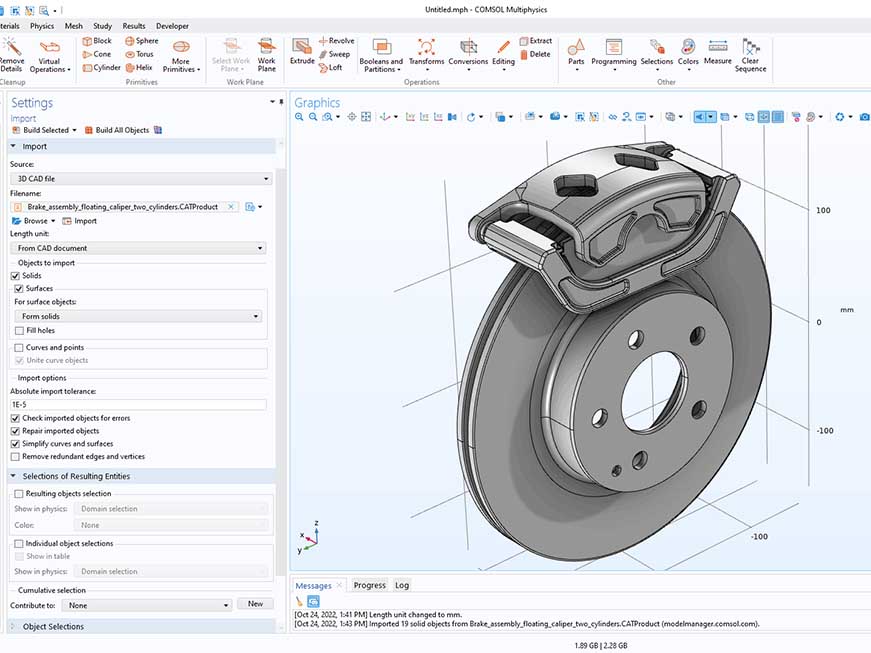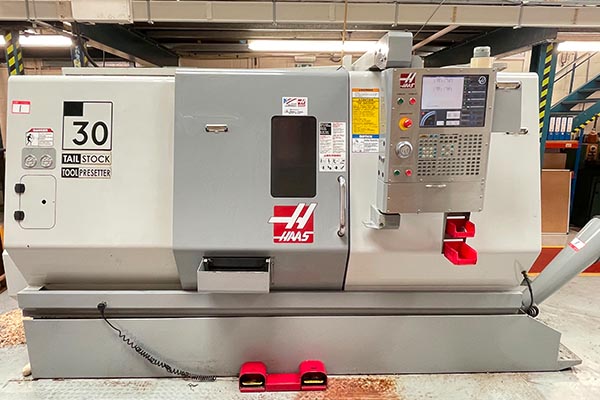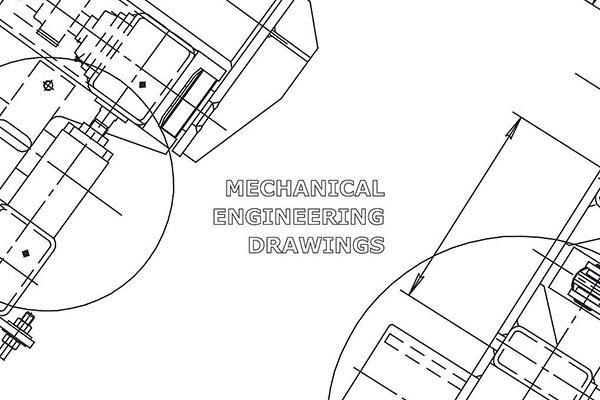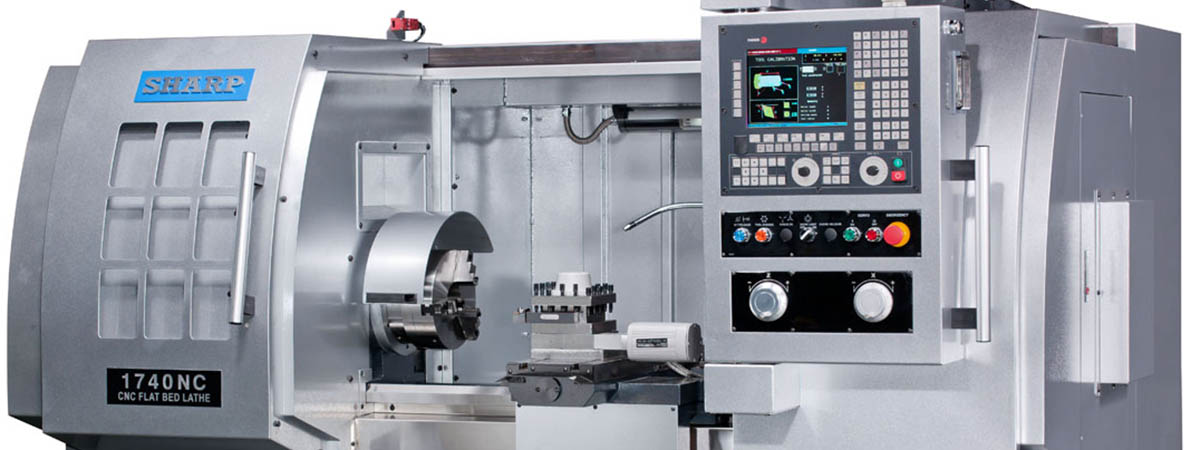
Interrogating machine tools present the lathe in the list of prominent players. These are multi-purpose tools that mold items into precision shapes. Generally, lathe machines are used in watch-making and aerospace sectors. In this article, you will find information about the lathes, how they work, their classification, and their importance in contemporary manufacturing.
What Is a Lathe?
A lathe is a machine used for shaping metals using rotation. It rotates the intended material while using a sharp-edge blade for slicing. Let’s take an example. Take an example of peeling the apple with the help of a knife while slowly twirling the apple. In this case, the apple refers to a workpiece, the spindle is the drive element and the knife is the cutting member. Therefore, a lathe holds the cutting tool against the revolving stock, which is then translated along a line subsidiary to the axis of rotation to produce a cylindrical shape.
How Does Lathe Machine Work?
Here are the steps involved in the lathe machine working;
1. Setup the Machine
It’s significant to provide a correct and secure workpiece grip on the lathe spindle. The appropriate mounting provides the right support during the machining process. One should use clips or some other fixtures on the implemented part to improve grip and stability. Ensure proper alignment to the right angles when cutting. This initial setup has a great influence on the final machining quality.
2. Select Lathe Cutting Tools
Ensure that the right lathe cutting tools are to the required standard of finish and size. Before use, tools should be inspected for wear and to ensure the cutting edge is sharp.
3. Adjust Speed and Feed
Adjust the spindle speed depending on the material being processed at the moment. Higher speed may be applied to softer materials while the harder ones call for slower speeds of the machine. Adjust the feed rate for the optimal combination of cutting rates and the tool’s durability. Supervision of these settings is necessary to avoid overheating during the operation of the corresponding automobile.
4. Commence Machining
Start the lathe and then guide the cutting tool. The hand should be steady to be able to get consistent outcomes. It’s necessary to monitor the material machining process and pay close attention to signs of deviation from the norm. Modify as required to increase precision.
5. Finishing Touches
After machining, always make a close examination of the workpiece. Scan for any cases of dimensional inaccuracies. Ensure, the quality standards are met immediately after any developing issues are noticed or reported. Clean the workpiece to remove any dirt, debris, scratches, or dust left from the process.
Key Components of a Lathe Machine
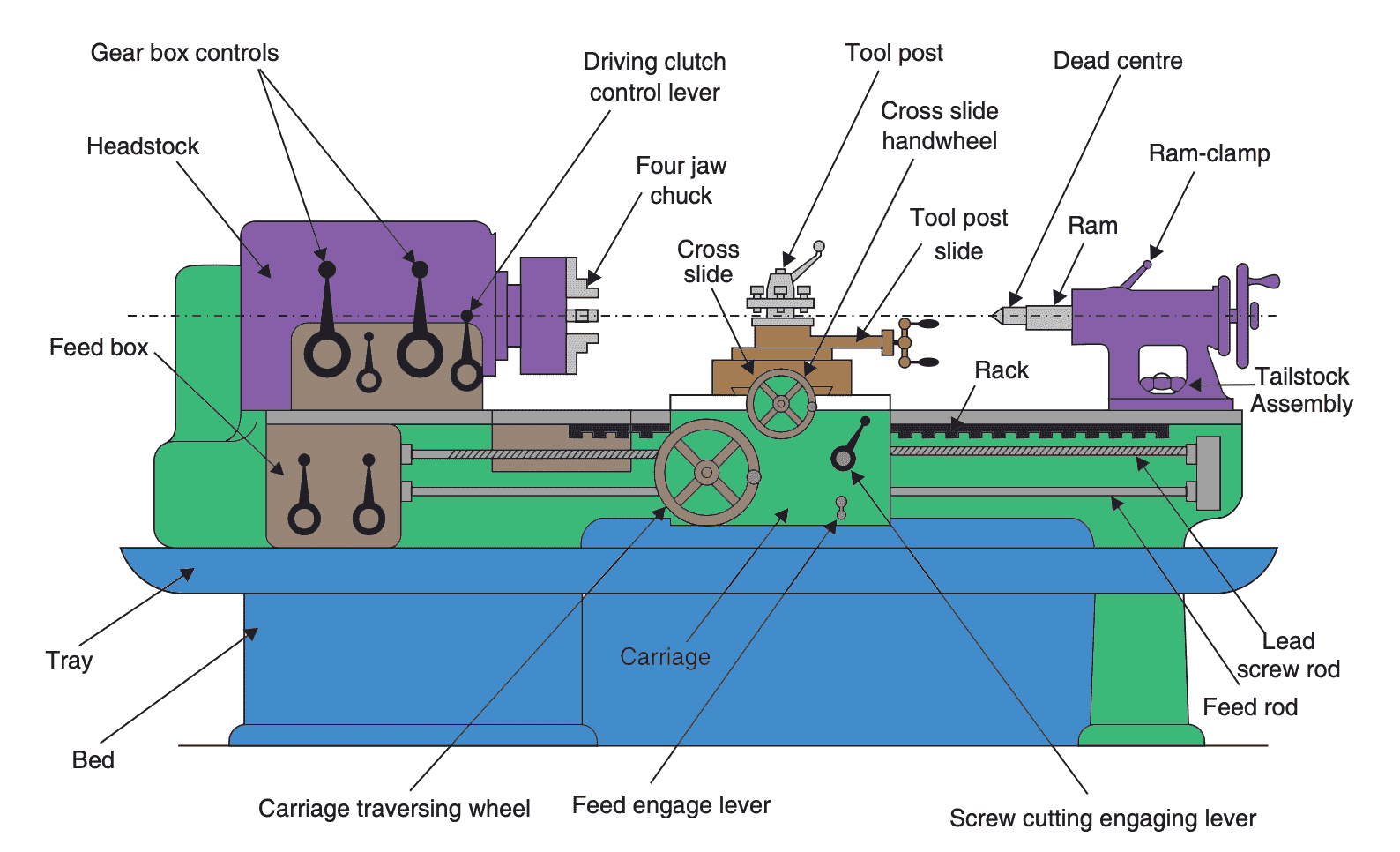
The core components of a lathe machine include;
1. Bed
The bed is a central and most massive part of the lathe on which other components of the lathe are mounted. Usually constructed of cast iron, it dampens vibrations during the operation. Machining accuracy and deflection are reduced when a rigid bed is used. Its length usually depends on workpiece sizes.
2. Headstock
The headstock contains the spindle and motor. It’s required to turn the workpiece during the process. Additionally, It holds the gearing system needed to adjust the spindle speed. Furthermore, the headstock can be fitted with a range of drives for its application as required.
3. Tailstock
The tailstock is situated on the opposite end of the headstock to hold the workpiece. It entails equipment for operations like drilling. Moreover, the tailstock can be adjusted to align it to the spindle line.
4. Carriage
The carriage holds a cutting tool. Typically, it’s mounted on the bed and rotates on it. In operation, it offers direct control of the tool position when practicing machining. The carriage has features such as cross slides and apron mechanisms.
5. Tool Post
The tool post offers support for the cutting tool. It enables tool changeover during the lathe process. The cutting angle can only be set correctly if the tool post is correctly adjusted. Moreover, it indicates that a well-functioning tool post is conducive to accuracy in an overall machining operation.
6. Spindle
The spindle is a fundamental part of the lathe machine. It rotates on the axis during the lathe operation. It controls the workpiece and determines its rotational speed. Spindle designs are fine-tuned in a way that holds an intricate level of runout which contributes to improved machining of the workpiece.
Common Types of Lathe Machines
In machining, lathes have a critical function of forming different materials. So, it’s crucial to determine the differences between each type of lathe because they have different purposes.
Engine Lathe
The most common types are the engine lathe, center lathe, and bench lathe. These lathes are well-known for their capabilities to compatibility with all material types, for instance; metals plastics, and ceramics. Engine lathes are optimal for a wide range of operations such as cutting, drilling, as well as sanding.
Turret Lathe
Turret lathes are the improved model of the engine lathe, as the main element in it – the turret – contains several tools. These designs enable tools to be changed quickly, and as such, are ideal for use in operations that require frequent tool replacement. Turret lathes are highly efficient since they ensure a high quality of the final product.
Tool Room Lathe
Tool room lathes are made for precise work, and to produce tools and dies. These lathes have additional settings for fine-tuning the machining parameters. As they are accurate, they are ideally used in highly detailed patterns.
Bench Lathe
Bench lathes are small machines used in precision work on small parts of a product. They are frequently installed on a workbench. These lathes are ideal for jewelry and watchmaking. Bench lathes come with considerable heft and high precision, despite their relatively compact nature.
CNC Lathe
CNC lathes are the advanced versions of conventional lathes where computer controls are to manage the operation. These machines can perform operations that manual lathes may not achieve. Commonly applicable for aircraft components. CNC lathes produce precise parts because of the accurate cutting of materials. These automation features improve operations’ efficiency to a high dimensional degree.
Vertical Lathe
Vertical lathes are also termed vertical turret lathes. These lathes entail vertical spindles for accommodating heavy workpieces. Moreover, their design enables the machining of large components that are typically difficult to handle in horizontal lathes. Verticle lathes are often employed in applications like aerospace, automotive, and electronic sectors.
Capstan Lathe
Capstan lathes are similar to turret lathes but are more suited for relatively small workpieces. These lathes are equipped with turret tools. This allows for quick control and adjustments during operation. These lathes are used where medium to large runs are necessary and accuracy and speed are utmost.
Wood Lathe
Wood lathes are used in woodworking to create various artistic pieces, as the name suggests. They are designed differently from metalworking lathes. However, wood lathes also use cutting tools. Their applications are versatile for making items such as table legs and bowls. They are designed to accommodate the funtional needs of woodworking projects.
Speed Lathe
A speed lathe has a simple structure. These are designed for high-speed operation. Unlike most other machines, these machines are designed for operations such as finishing and polishing as opposed to intricate cutting. As they hold fewer components, they aim to get a better surface finish. Speed lathes are commonly used in woodturning and metal polishing projects.
Vertical Turret Lathe (VTL)
Vertical Turret Lathe (VTL) has a vertical spindle arrangement. This feature makes it possible to work on large and heavy workpieces, typically challenging for mounted on ordinary lathes. VTLs are common in large industries where large components need operations such as turning and facing. Their design improves the capacity to machine large parts.
Gap Bed Lathe
Cylindrical bed lathes are another type of lathes, which have a cantilevered style structure and, a section of the bed that can be removed. This feature enables them to deal with large-diameter workpieces. The gap can be adjusted or even eliminated to suit different machining applications thus making it easy to operate. These lathes are beneficial in general-purpose machining because they can adapt to different situations easily.
Automatic Lathe
Automatic lathes are designed for high production capacity. They do operations with little or no intervention from the operator. Such systems effectively control tool change and workpiece feeding on their own. So, these are best suited to high-volume production and well-suited for the manufacturing of identical parts.
Metal Lathe
Metal lathes are sturdy equipment normally designed for shaping metal parts. These lathes can accommodate all metals and include high accuracy in cutting, turning, and drilling. These often come in different sizes and shapes to suit particular machining requirements. Turning is usually applied in the automotive and aerospace industries to produce accurate parts.
Glass Working Lathe
Glassworking lathes are precise tools used for cutting or molding glass in a certain manner. These lathes help control the glassworking process and guarantee the best outcomes. They are normally employed in artistic glassworks and scientific laboratories.
Mini/Micro Lathe
Mini and micro lathes are small machines used in home use, schools, and colleges. Despite their compactness, they are ideal for restricted areas, but they can handle numerous functions well. These lathes are a favorite among lovers of turning and drilling. Although they are small, and provide optimum functionality for small-scale projects.
CNC Swiss-Type Lathe
The CNC Swiss-type lathes are designed to machine long thin and highly accurate components. This design brings the workpiece near the cutting tool and, thereby, increases accuracy. These are originally designed for watchmaking and producing detailed medical devices.
Common Operations Performed on a Lathe Machine
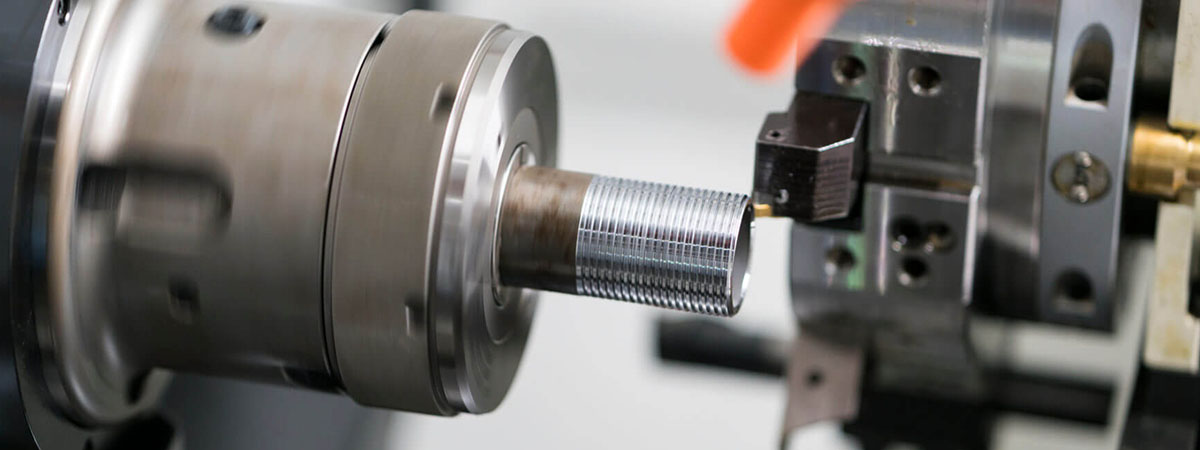
Below are the key tasks commonly handled by CNC Lathe machines:
1. Turning
CNC turning rotates the workpiece against a stationary cutting tool to convert shapes and materials into a symmetrical form. This operation enables the creation of external and internal diameters. Turning can be done in two ways; rough turning where material is turned rapidly to remove material and finish turning where the surface of the job is turned at a slower rate.
2. Facing
Facing levels off the end of a workpiece and the cutting tool is perpendicular to the rotational direction. Flattening the reference surface improves accuracy and dimensional tolerance in lathe operations.
3. Drilling
Drilling makes holes in the workpiece by using a drill bit held in the tailstock. The tool design enables different hole sizes and depths to be produced when the bit is fed into the rotating piece. In addition, drilling operations include counterboring and tapping.
4. Boring
Boring works by increasing hole sizes to give the right size. A boring bar with a cutting tool makes holes bigger and better. This operation is critical for all applications that need close tolerance, used widely in automotive and aerospace products.
5. Knurling
Knurling simply produces a rough or raised pattern on the intended workpiece. A knurling tool applies pressure on the rotating material to increase the friction and make the surface aesthetically appealing. Some common application includes handles, knobs, and grips on tools.
6. Parting
Partying is a process whereby a thin parting tool is used to cut the workpiece from the main stock. This operation helps produce individual components with good separation. It shapes them with minimal material waste. Parting if done correctly will make this whole process more efficient.
7. Threading
Cutting threads on a workpiece takes helical grooves, which may be done by single-point threading or dies. Both internal and external threads are possible to be made. This ensures precise threading for screws and fittings.
8. Taper Turning
Taper turning involves the gradual reduction of the workpiece diameter along its longitudinal length. This can be accomplished using a taper attachment. In assembly applications, it’s important to take great care. This ensures that taper turning fits perfectly.
9. Polishing
Polishing improves the surface roughness of the workpiece which influences the aesthetic value. It is mostly a standalone process. However, it can also be done on a lathe using specific tools or compounds.
10. Chamfering
The chamfering process helps reduce the sharp edge of a workpiece and gives it a tapered edge. This operation makes safety better and allows for easier assembly. In addition, the edge treatment is more efficient by using a chamfering tool since it improves both form and function.
Materials That Can Be Used on a Lathe
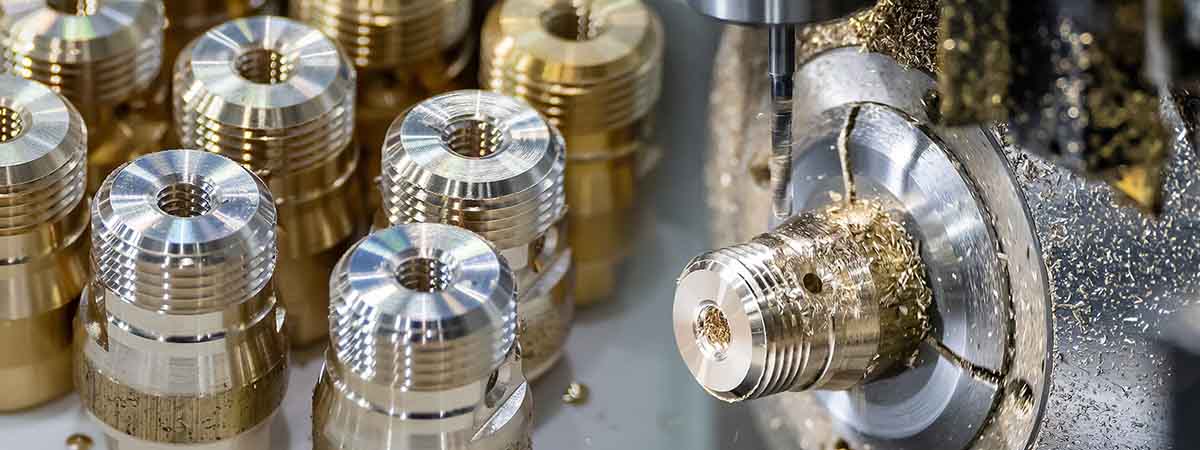
Lathes can be used on almost any type of material to be machined. Here are some common materials that can be effectively worked on a lathe:
1. Metals
- Steel: Commonly used because of its strength and hardness. Carbon steel and alloy steel are often turned and milled.
- Aluminum: It is particularly used for its lightweight and corrosion resistance. Moreover, aluminum machines well and can be used to produce very fine cutting patterns.
- Brass: A copper-zinc alloy comprises good machinability and a bright surface finish.
- Copper: Copper is appreciated for use in electrical conduction. The machining of copper is quite sensitive since it can be prone to deformation.
2. Plastics
- Acrylic: Gives a clear appearance and good UV transmission properties, making it a deal for use in optical parts.
- Polycarbonate: Popular for its hard and shock-absorbing nature. Also, it’s perfect for exploiting areas that need strength and clear visibility.
- Nylon: Show high and low coefficient of friction and excellent wear characteristics. It is widely applied for gears, bushing, and other moving parts.
3. Wood
- Hardwoods: Oak, maple, and cherry woods are used for strength as well as the appearance of the furniture made from the wood type in question. These woods are used in fine furniture and cabinetry.
- Softwoods: Like pine and cedar normally used for construction and carving of decorative items etc.
4. Composites
- Fiberglass: These are made up of glass fibers in a resin matrix and deliver strength and low weight. Machining is a rather abrasive process which is why it needs specialized tools.
- Carbon Fiber: It is characterized by a lightweight structure but has high mechanical strength. Most frequently used in the aerospace and automotive industry for prototyping.
5. Ceramics
- Alumina: Popular for its hardness and resistance to wear. It is applied in products such as cutting tools and wear parts.
- Silicon Nitride: It has good thermal stability as well as mechanical strength of the material.
Benefits and Drawbacks of Lathe Machines
| Aspects | Benefits | Drawbacks |
| Materials | Accommodates diverse materials: metals, plastics, and composites. | Not suitable for machining non-rotational or complex geometries. |
| Precision Machining | Achieves tight tolerances with high dimensional accuracy for cylindrical parts. | Precision may degrade without proper calibration and skilled operation. |
| Operational Flexibility | Facilitates multiple processes (turning, drilling, boring) within a single setup. | Tool change and setup times can hinder continuous production efficiency. |
| Production Scalability | Effective for both mass production and custom one-off components, enhancing workflow. | Increased tooling costs and frequent maintenance can affect overall profitability. |
| Surface Finish Capability | Capable of delivering high-quality surface finishes through appropriate tool selection and techniques. | Inconsistent maintenance can lead to surface defects and diminished performance. |
How Much Does Lathes Cost?
The cost of a lathe depends on type, dimension, and utilization. Here’s a breakdown of typical costs:
- Bench Lathes: Intended for small precision work, these can cost as low as $200 and up to $3,000.
- Engine Lathes: Engine lathes are widely used in different industries due to their diverse applications. Usually, these costs are within the range of $1000 to $20000 depending on their size and additional functions.
- Toolroom Lathes: These high precision machines cost from $4,000 to over $30,000 depending on their design features and accuracy.
- CNC Lathes: Sophisticated and computerized, CNC lathes are available for $8,000 and can go up to more than $ 100,000 for superior quality.
Thus, the final price depends on some particular characteristics, a brand, and extra features that can be integrated into an enclosure, such as digital screens or specific tool holders.
How Accurate are Lathe Machines?
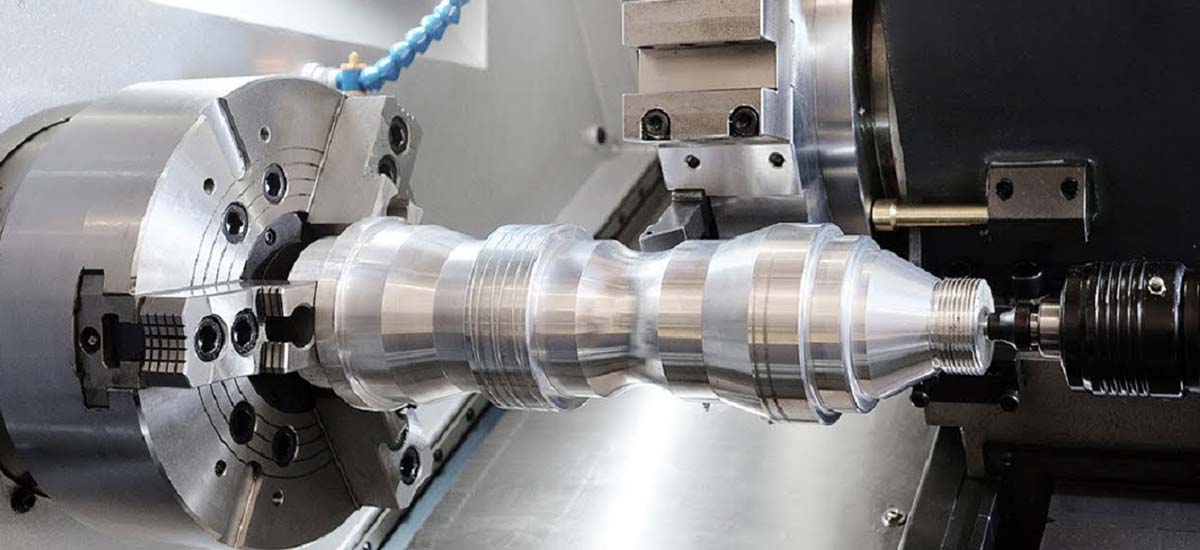
The level of precision varies based on the lathe type and its construction:
- Manual Lathes: These machines are normally accurate to about 0.001 inches (0.025 mm), which is fine for the majority of conventional machining applications.
- CNC Lathes: Featuring greater accuracy, it can be possible to achieve tolerances of 0.0005 inches (0.0127 mm) or can even produce smaller parts due to its automated, computer numerical control operation.
- Toolroom Lathes: Designed for accuracy, toolroom lathes can provide extremely accurate results for specific jobs.
How to Select the Right Lathe?
Choosing the appropriate lathe requires careful consideration of several key factors:
- Workpiece Dimensions: Ensure that the lathe you are going to select is capable of accommodating small-size and lighter workpiece materials.
- Material Compatibility: They are suitable for the sort of material you want to work either metal, plastic, or wood.
- Accuracy Needs: Some extra features may be important: get a lathe with digital readouts if accuracy is a special priority.
- Financial Considerations: Compare your budget to what features are needed and the machine quality required.
- Available Space: Check your workshop dimensions to ensure it will accommodate the size of the lathe and workspace needed for it to function.
- Usage Intent: If preparing for regular or intensive use lathe, it would be advised to search for a more powerful, industrial-use lathe.
Alternative Technologies to Lathes
Lathes play a crucial role in CNC machining, but several alternative technologies also offer unique capabilities:
CNC Milling Machine
Milling machines are different from lathes. These are notably used to make various cuts and shapes with considerable detail. They can drill, cut, tap, and slot on metals and plastics among other materials.
3D Printing
3D printing is a beneficial additive manufacturing technique for the creation of intricate shapes. This technology assembles structures from the base materials, for instance, plastics and metal alloys successively. Although not as fast as some of the conventional approaches, 3D printing is incredibly accurate and nearly indestructible.
Laser Cutting
Laser cutting is a process of cutting or engraving through the use of a laser beam. This method is particularly suitable for thin materials, such as sheet metal and acrylic glass. Laser cutting can attain high precision levels; so employed in fabrication industries and the jewelry trade.
Water Jet Cutting
Water jet cutting uses high-pressure water and a garnet abrasive mix to cut through different materials. In particular, it effectively deals with thicker and harder materials such as metal and ceramic. The major features of this technology are precision and flexibility for use in aerospace and art industries. Heat distortion is prevented, thus material characteristics are not compromised.
CNC Router
CNC routers are designed for cutting wood, composite, and lightweight metals. These machines are best suited for large, planar materials. Moreover, these are capable of delivering difficult designs. CNC routers are frequently utilized in wood carving and the production of signs.
Conclusion
Lathe machines remain essential in production, while other technologies offer specific applications. Companies like Premium Parts use these advancements to meet diverse industrial needs. Although other solutions have their advantages, none can produce identical twin and highly accurate parts like a lathe.



